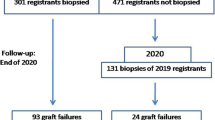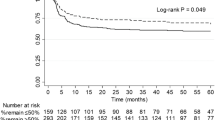Abstract
The data base of the North American Pediatric Renal Transplant Cooperative Study (NAPRTCS) was used to examine the effect of primary diagnosis on the outcome of renal transplantation in children. The relative risk of graft failure for eight diagnostic groups was determined, with patients with congenital and structural anomalies of the urinary tract serving as the reference group. Covariate analysis was used to control for the effects of age, race and transfusion history in recipients of living-related donor kidneys, and for age, donor age, antilymphocyte prophylaxis, prior transplantation, prior dialysis and cold ischemia time in recipients of cadaver kidneys. In recipients of living-related donor kidneys, the lowest graft failure rates were associated with the diagnoses of cystinosis, familial nephritis and hemolytic uremic syndrome (HUS), while the highest failure rates were observed in patients with a primary diagnosis of congenital nephrotic syndrome (CNS) or focal segmental glomerulosclerosis (FSGS). In cadaver allograft recipients, the lowest graft failure rates were associated with primary diagnoses of glomerulonephritis, congenital/structural disease and cystinosis, while patients with FSGS, HUS and CNS had the highest graft failure rates. This study suggests that patients with a primary diagnosis of cystinosis have superior outcomes, while the diagnoses of FSGS and CNS carry with them the highest risks of graft failure.
Similar content being viewed by others
References
McEnery PT, Stablein DM, Arbus G, Tejani A (1992) Renal transplantation in children: a report of the North American Pediatric Renal Transplant Cooperative Study. N Engl J Med 326: 1727–1732
Chavers BM, Kim E, Matas AJ, Gillingham KJ, Najarian JS, Mauer SM (1994) Causes of kidney allograft loss in a large pediatric population at a single center. Pediatr Nephrol 8: 57–61
Striegel JE, Sibley RK, Fryd DS, Mauer SM (1986) Recurrence of focal segmental sclerosis in children following renal transplantation. Kidney Int [Suppl] 30: S44-S50
Stephanian E, Matas AJ, Mauer SM, Chavers B, Nevins T, Kashtan C, Sutherland DER, Gores P, Najarian JS (1992) Recurrence of disease in patients retransplanted for focal segmental glomerulosclerosis. Transplantation 53: 755–757
Ingulli E, Tejani A (1991) Incidence, treatment and outcome of recurrent focal segmental glomerulosclerosis posttransplantation in 42 allografts in children — a single-center experience. Transplantation 51: 401–405
Watts RWE, Morgan SH, Danpure CJ, Calne RY, Rolles K, Baker LRI, Mansell MA, Smith LH, Merion RM, Lucey MR (1991) Combined hepatic and renal transplantation in primary hyperoxaluria type I: clinical report of nine cases. Am J Med 90: 179–188
Cameron JS, Senguttuvan P, Hartley B, Rigden SP, Chantler C, Koffman G, Williams DG, Ogg CS (1989) Focal segmental glomerulosclerosis in fifty-nine renal allografts from a single center: analysis of risk factors for recurrence. Transplant Proc 21: 2117–2118
Tejani A, Stablein DH (1992) Recurrence of focal segmental glomerulosclerosis posttransplantation: a special report of the North American Pediatric Renal Transplant Cooperative Study. J Am Soc Nephrol 2: S258-S263
Broyer M, Ehrich J, Jones E, Selwood N (1993) Five year survival of kidney transplantation in children: data from the European (EDTA-ERA) registry. Kidney Int 44 [Suppl 43]: S22-S25
Almond PS, Matas AJ, Nakleh RE, Morel P, Troppman C, Najarian JS, Chavers B (1993) Renal transplantation for infantile cystinosis: long-term follow-up. J Pediatr Surg 28: 232–238
Ehrich JHH, Brodehl J, Byrd DI, Hossfeld S, Hoyer PF, Leipert K-P, Offner G, Wolff G (1991) Renal transplantation in 22 children with nephropathic cystinosis. Pediatr Nephrol 5: 708–714
Cox DR (1972) Regression models and life tables. J Royal Statistical Soc B 34: 187–220
Kaplan EL, Meier P (1958) Nonparametric estimation from incomplete observations. J Amer Statistical Assoc 53: 457–481
Cameron JS (1994) Recurrent primary disease and de novo nephritis following renal transplantation. In: Tejani AH, Fine RN (eds) Pediatric renal transplantation. Wiley-Liss, New York, p 503
Hoyer JR, Vernier RL, Najarian JS, Raij L, Simmons RL, Michael AF (1972) Recurrence of idiopathic nephrotic syndrome after renal transplantation. Lancet II: 343–348
Hebert D, Sibley RK, Mauer SM (1986) Recurrence of hemolyticuremic syndrome in renal transplant recipients. Kidney Int 19 [Suppl]: 51–58
Hebert D, Kim E, Sibley RK, Mauer SM (1991) Post-transplant outcome of patients with hemolytic-uremic syndrome: an update. Pediatr Nephrol 5: 162–167
Bassani CE, Ferraris J, Gianantonio CA, Ruiz S, Ramirez J (1991) Renal transplantation in patients with classical hemolytic-uremic syndrome. Pediatr Nephrol 5: 607–611
Fitzpatrick MM, Walters MDS, Trompeter RS, Dillon MJ, Barratt TM (1993) Atypical (non-diarrhea-associated) hemolytic-uremic syndrome in childhood. J Pediatr 122: 532–537
Gahl WA (1986) Cystinosis coming of age. Adv Pediatr 33: 95–126
Kashtan CE, Michael AF (1993) Alport syndrome: from bedside to genome to bedside. Am J Kidney Dis 22: 627–640
Kashtan CE (1990) Ask the expert. Pediatr Nephrol 4: 248
Author information
Authors and Affiliations
Rights and permissions
About this article
Cite this article
Kashtan, C.E., McEnery, P.T., Tejani, A. et al. Renal allograft survival according to primary diagnosis: a report of the North American Pediatric Renal Transplant Cooperative Study. Pediatr Nephrol 9, 679–684 (1995). https://doi.org/10.1007/BF00868709
Received:
Revised:
Accepted:
Issue Date:
DOI: https://doi.org/10.1007/BF00868709




